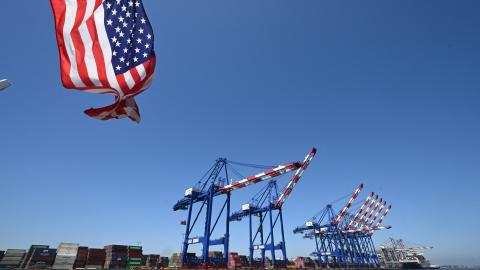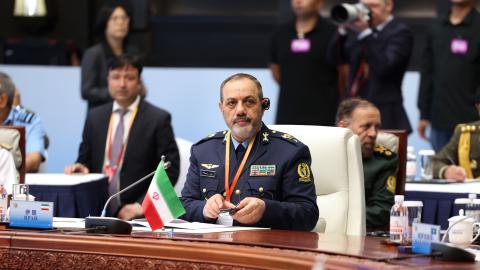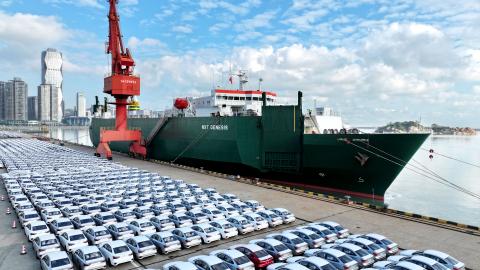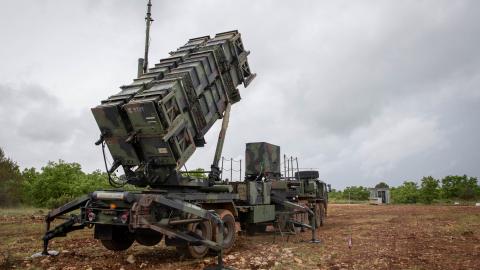In the 1600s, before our nation was formed, Cotton Mather, a New England religious and civic leader, called for Americans and their voluntary associations to engage in "a perpetual endeavor to do good in the world." Noting the unique strength of America's charities and other "mediating institutions," Alexis de Tocqueville in the 1830s remarked on the contributions they make to society, independent of government. Since early relief efforts in Greece in the 1840s and in famine-racked Ireland, Americans have delivered financial assistance and fostered compassion, dignity of the individual and volunteerism abroad.
So, when the tsunami disaster struck just two weeks ago, Americans stepped up to the plate again. But, in larger and more innovative ways than we have ever seen before.
As of late last week, the U.S. government has pledged $350 million in tsunami relief aid. And then there is the massive contribution by the U.S. military. Over 13,000 service members, 14 Navy ships, including the carrier Abraham Lincoln and 90 helicopters plus military transport aircraft are in the region delivering supplies. Years of multinational training for humanitarian disasters in Southeast Asia have paid off. These exercises, held in Thailand every year, focus specifically on disaster relief and peacekeeping.
Yet the most creative aid channel is proving to be the private sector. Internet servers and businesses like Yahoo!, America Online, eBay, and Amazon.com created links and space for charitable organizations so readers could quickly and easily donate to them. Companies like Best Buy and Merck established matching gift programs for employees donating to relief organizations. United Airlines is giving out bonus frequent flyer miles to people who contribute to one of their partner charities.
NBA players Tracy McGrady, Kobe Bryant and Jermaine O'Neal promised to give $1,000 for every point they score over a week's time. And, in Chattanooga, Tenn., a municipal court judge is giving errant motorists the option of donating $100 to tsunami relief rather than pay a traffic fine. All over America, schools, churches and neighborhoods are raising money for the victims of one of the largest natural disasters in modern times.
The 5 million people affected by this catastrophe—those injured and left homeless without food, water or medicines—far surpassed the estimates last week of well over 150,000 dead. By the end of the second week of the disaster, governments and international organizations had pledged $5.6 billion in total assistance. The largest government donors are Australia, Germany, Japan and the United States, along with various international organizations, including the International Monetary Fund, the United Nations Development Program, the United Nations High Commission for Refugees, and the World Bank.
Relief efforts are still encountering problems of insufficient warehouse and runway space, along with damaged roads, sanitation and water systems. Yet, some relief workers believe they are turning the corner in helping the victims. United Nations officials said relief efforts in Banda Aceh, the hardest hit area in Indonesia, could reach up to 800,000 people. Food supplies were expected to reach 130,000 and food markets in at least half of the provincial city capital were starting up again.
Politics got in the way during the first week of the tsunami disaster. After the United States pledged an initial $15 million, U.N. Relief Coordinator Jan Egeland reproached the United States and other rich countries for being "stingy" with foreign aid in general. The Bush administration upped its assistance to $350 million for the tsunami catastrophe, with more aid probable, but the charges lingered. The criticism stems from the long-touted fact that U.S. foreign aid ranks last among developed countries as a percent of Gross National Income.
Americans are surprised by this statistic because we generally think of ourselves as a generous people. Why isn't the richest nation in the world giving more, and thus ranking higher?
The answer is simple. For one thing, the United States gives the highest absolute amount in foreign aid of any country—in 2003, more than $16 billion. Secondly, the U.S. government contribution of $350 million does not take into account what the U.S. military is spending in one of its largest military relief operations ever.
But most importantly, Americans give far more beyond our government assistance.
Americans generally help people abroad the same way they help people at home—through our private charities, religious organizations, foundations, corporations, universities, and remittances from immigrants sending dollars to their needy family members back home.
Hudson Institute research tallied over $35 billion in private foreign aid for 2000 (the last year such figures were tabulated). That's three and one-half times U.S. government aid for that year. And even this large amount low-balls American contributions abroad, as it does not include giving by local U.S. churches or donations by overseas affiliates of U.S. corporations.
The common measure used by the U.N. and European countries—the percent of gross national income used for foreign aid—counts only government foreign aid. It does not fully take into account private giving for those in need abroad. This "donor performance measure" may have been appropriate when established in the 1950s, but it is outmoded today. For it omits the overwhelming growth in international private philanthropy.
The 2004 Foundation Center publication, International Grantmaking III, reports that international foundation giving grew much faster than overall giving between 1998 and 2002. The share of dollars for international causes has also risen to 14 percent of total foundation giving, up from 11 percent in 1998. The funding outlook for U.S. foundation giving remains strong, and half of all American corporate givers plan increases.
So it is not surprising that private donations to the tsunami disaster are growing each day, coming closer to the total of U.S. government contribution. The Chronicle of Philanthropy reported Jan. 7 that Americans had donated $324 million to American charities providing tsunami relief. This is likely underestimated since it does not include individuals sending private donations to overseas charities and family members in Asia, or contributions from U.S. companies and individuals in Asia going directly to local charities in the region. Nor does it include donations in kind such as medicines from pharmaceutical companies. They have donated $32 million in medicines already along with the same amount in cash to charities. Most have set up matching gift programs with their employees that will bring in additional funds.
With the private fund-raising effort led by former Presidents Bush and Clinton, private donations will most assuredly continue to grow and exceed the U.S. government level.
In essence, foreign aid is privatizing—just as transportation, energy and telecommunications have been privatized in many parts of the world. As economic growth has increased in developing nations, so have local charities, business philanthropy and community foundations.
There is a lot to say for private giving. For too long, commitment to the poor abroad has been measured by how much is spent, rather than how well. Private giving is usually faster, more nimble, more direct and accountable. It uses less overhead than expensive government consultants, and can better avoid interference by corrupt officials in countries afflicted by natural disasters, such as tsunamis and earthquakes.
By needing to raise their own funds and volunteers, private philanthropy stands a kind of market test, which is not required by unelected government and international bureaucrats. Thus, it is no surprise that some of the first donors on the scene in India and Sri Lanka were private relief groups and business executives giving out desperately needed food, water and medicines. The day after the earthquake, Catholic Relief Services, the Baltimore-headquartered U.S. relief organization, already had given $200,000 in grants to India for the immediate purchase of rice, medical supplies and sleeping mats for camps and clinics.
The Europeans assist the needy abroad as they do to the needy at home, primarily through government programs. They prefer government-to-government assistance in their foreign aid, whereas Americans prefer people-to-people aid. Thus, the measure used to compare the U.S. with European countries is not a true comparison because it does not fully take into account private giving, where the contributions in the United States are significantly larger than those in Europe.
The outdated measure of government aid as a percent of its gross national income omits other factors critical to development abroad. For instance, the United States has long provided the most foreign direct investment in developing countries, which creates long-term and sustainable development. America provides the bulk of the world's R&D, which saves millions of lives in poor countries through improvements in food and medicines. And, of course, our military presence abroad helps provide the stability so essential to economic growth and democracy.
Using the right measures--which include these factors, as well as the staggering amounts of private giving--shows that Americans are a most generous people. Rather than pointing fingers at America, the United Nations, Europeans and international organizations should hold hands with private donors and focus on getting the job done.
The response to Asia's tsunami disaster is showing that the United States continues to live up to its tradition of helping others in times of need. Americans are responding with their historic and characteristic generosity, way beyond the U.S. government giving $350 million or even more.
















